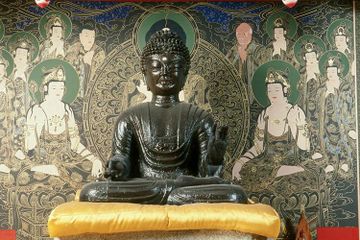충주 철조여래좌상
| 충주 철조여래좌상 Iron Seated Buddha, Chungju |
|
 충주 철조여래좌상, 국가문화유산포털, 문화재청. |
|
| 대표명칭 | 충주 철조여래좌상 |
|---|---|
| 영문명칭 | Iron Seated Buddha, Chungju |
| 한자 | 忠州 鐵造如來坐像 |
| 주소 | 충청북도 충주시 사직산12길 55, 대원사 (지현동) |
| 지정(등록) 종목 | 보물 제98호 |
| 지정(등록)일 | 1963년 1월 21일 |
| 분류 | 유물/불교조각/금속조/불상 |
| 시대 | 고려시대 |
| 수량/면적 | 1구 |
| 웹사이트 | 충주 철조여래좌상, 국가문화유산포털, 문화재청. |
해설문
국문
충주 철조여래좌상은 고려시대에 만들어진 불상으로, 충주 대원사 극락전에 있다. 불상은 충주 공업고등학교 근처에서 관아공원으로 옮겨졌다가 일본인이 운영하던 마하사(摩訶寺)를 거쳐 1959년부터 대원사에서 모시고 있다. 불상이 처음 모셔진 절이나 위치는 알 수 없으나, 안림동 대원고등학교 근처에 고려 시대 절인 의림사의 절터가 남아 있으며, 여기에서 고려 명종 20년(1190)에 제작한 금고(金鼓)*가 출토된 바 있어서 원래의 위치를 추정해 볼 수 있다. 충주에는 이 철불 외에도 충주 백운암 철조여래좌상(보물 제1527호)과 충주 단호사 철조여래좌상(보물 제512호)이 전해지고 있어서 충주가 과거에 철이 많이 생산된 곳이었음을 알 수 있다.
불상의 높이는 98cm로 오른발을 왼쪽 무릎 위에 올린 결가부좌 자세를 하고 있으며, 머리카락은 소라 껍데기처럼 틀어 말아 올린 모양을 하고 있다. 좁은 이마와 뚜렷한 이목구비, 위로 올라간 눈꼬리와 꼭 다문 입이 근엄한 인상을 준다. 목에는 삼도(三道)**가 있으며, 양어깨에 걸쳐 입은 옷은 좌우 대칭을 이루고 있고 가슴 앞에는 띠 매듭이 표현되어 있다. 날카로운 인상과 좌우 대칭의 다소 비현실적인 옷 주름 묘사에서 충주 지역에 남아 있는 철불의 특징이 엿보인다.
- 금고(金鼓): 절에서 쓰는 북 모양의 종
- 삼도(三道): 불상의 목에 표현된 세 줄의 주름
영문
Iron Seated Buddha, Chungju
This iron statue, enshrined in Geungnakjeon Hall of Daewonsa Temple, depicts a seated buddha and dates to the Goryeo period (918-1392). Found in the vicinity of Chungju Technical High School (about 1 km to the southeast), the statue was relocated several times until it was brought to Daewonsa Temple in 1959. The name or the location of the Buddhist temple where the statue was originally enshrined remains unknown. Some presume that it could have been Uirimsa, a Goryeo-period temple located in Allim-dong (about 2 km to the east) near Daewon High School. A metal gong made in the year 1190 was found at the Uirimsa Temple Site.
The statue measures 98 cm in height. The buddha is depicted sitting with his legs crossed and his right foot resting on his left knee. He has curly hair and a large protuberance atop his head which symbolizes his wisdom. The buddha’s solemn appearance is accentuated by his narrow forehead, prominent facial features, eyes slanting upwards, and stiff closed mouth. The three creases on his neck and upper chest represent the “three destinies” of afflictions, actions, and suffering. The buddha’s garment is draped over both of his shoulders and features symmetrical folds on the right and left sides, as well as a garment knot on his chest. The sharp impression and symmetrical garment folds are characteristic of the Buddhist iron statues of the Chungju area.
There are two other Buddhist iron statues in Chungju, one at Baegunam Hermitage and one at Danhosa Temple (both designated as Treasures), which shows that iron was produced at a large scale in this area in the past.
영문 해설 내용
대원사 극락전에 모셔져 있는 이 철조여래좌상은 고려시대에 만들어졌다. 남동쪽으로 1km 정도 떨어진 충주공업고등학교 근처에서 처음 발견된 뒤 여러 곳으로 옮겨지다가, 1959년부터 대원사에서 모시고 있다. 불상이 처음 모셔진 절이나 그 절의 위치는 알 수 없다. 동쪽으로 2km 정도 떨어진 안림동 대원고등학교 근처에 있던 고려시대 사찰 의림사에 모셨던 것으로 추정하기도 한다. 의림사터에서는 1190년에 제작한 금고(金鼓)가 출토된 바가 있다.
불상의 높이는 98cm이다. 오른발을 왼쪽 무릎 위에 올린 결가부좌 자세를 하고 있으며, 소라 모양의 머리카락으로 덮여 있는 머리에는 부처의 지혜를 상징하는 육계가 있다. 좁은 이마와 뚜렷한 이목구비, 위로 올라간 눈꼬리와 꼭 다문 입이 근엄한 인상을 준다. 목에는 번뇌, 업, 고통을 상징하는 삼도가 새겨져 있다. 양어깨에 걸쳐 입은 옷은 좌우 대칭을 이루고 있고, 가슴 앞에는 띠 매듭이 표현되어 있다. 날카로운 인상과 좌우 대칭의 옷 주름 등은 충주 지역에서 만들어진 철불의 특징이다.
충주에는 이 불상 외에도 백운암 철조여래좌상(보물)과 단호사 철조여래좌상(보물) 등 철조 불상들이 전해지고 있어서, 충주가 과거에 철이 많이 생산된 곳이었음을 알 수 있다.